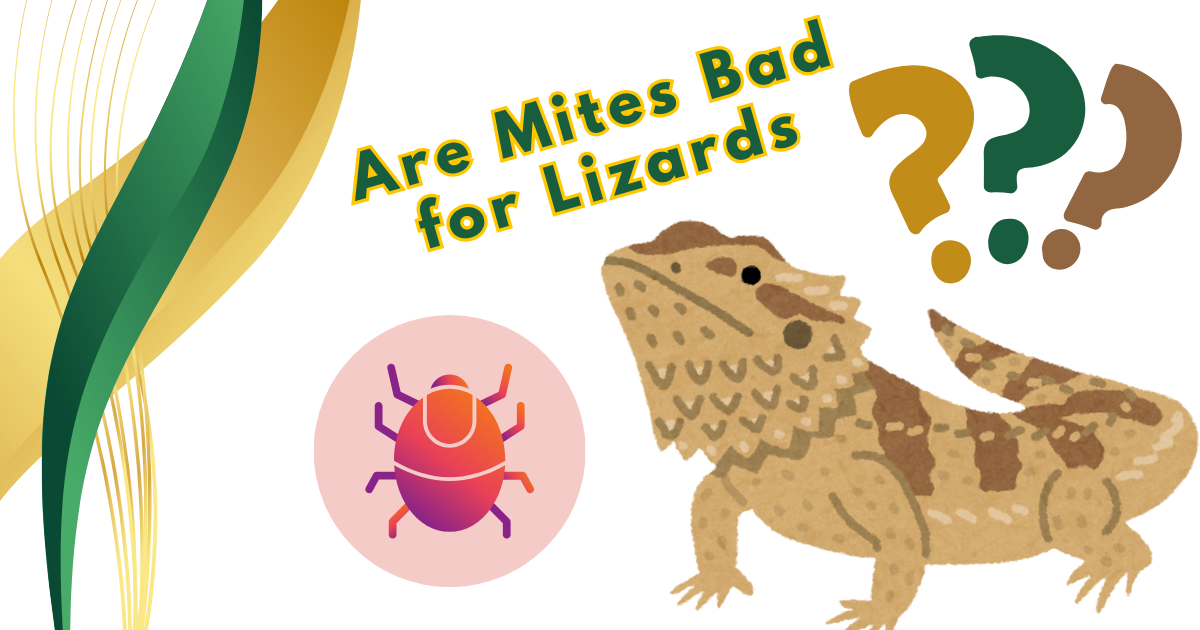Mites might be small, but their impact on lizards can be significant. These tiny parasites attach to the skin of reptiles, feeding on their blood and causing a wide range of health problems. Whether you’re a seasoned reptile owner or a beginner, understanding are mites bad for lizards is crucial for ensuring the well-being of your pet.
In this blog post, we will explore why mites are bad for lizards, the signs of a mite infestation, and the best ways to treat and prevent mites from harming your reptilian companions. By the end, you’ll be armed with the knowledge needed to protect your lizard from these dangerous pests.
What Are Mites? Understanding These Tiny Parasites
Mites are small, arachnid parasites that feed on the blood of reptiles, including lizards. Though they may seem like minor annoyances at first, mites can cause severe health problems if left untreated. There are different species of mites, but the ones most commonly associated with lizards include Ophionyssus natricis, commonly known as the snake mite, which also affects other reptiles, including lizards.
Where Do Mites Come From?
Mites can be introduced to your lizard’s environment through a variety of sources:
- New reptiles brought into the home
- Contaminated bedding or substrate
- Handling or exposure to other infected animals
Mites are highly contagious and can spread rapidly from one reptile to another, making it essential to quarantine any new pets and thoroughly clean their enclosures before introduction.
Life Cycle of a Mite
Mites go through several stages of development, from egg to larvae, nymph, and finally to adult. They breed quickly, with the female laying eggs in the crevices of the reptile’s enclosure, which hatch into larvae and begin feeding on the host within just a few days. Because of their rapid reproduction cycle, a small infestation can quickly grow out of control.
How Do Mites Affect Lizards? The Dangers Explained
Mites are more than just an irritant for lizards—they can lead to serious health problems. Below are five ways that mites negatively impact lizards:
1. Blood Loss and Anemia
Mites feed on the blood of lizards, and a significant infestation can lead to anemia due to the constant blood loss. Lizards affected by mites may become lethargic and weak, showing a reduced appetite and decreased activity levels. Severe blood loss can be life-threatening, particularly for smaller or younger lizards.
2. Skin Irritation and Infection
Mite bites cause itching, irritation, and skin damage. Affected lizards may scratch themselves excessively against objects in their enclosure, leading to sores and open wounds. These wounds can become infected, introducing bacterial infections that require medical treatment.
3. Stress and Behavioral Changes
A lizard with mites will often exhibit changes in behavior due to stress and discomfort. This may include:
- Restlessness
- Constant rubbing or scratching
- Hiding more frequently than usual
- Decreased appetite
Left untreated, the stress caused by a mite infestation can severely weaken a lizard’s immune system, making it more susceptible to illness.
4. Impaired Shedding
Mites can interfere with a lizard’s natural shedding process, making it difficult for them to fully shed their skin. This condition, known as dysecdysis, can cause retained shed skin to build up, particularly around the eyes, mouth, and limbs. This buildup may lead to restricted movement, infections, and even loss of digits if not treated promptly.
5. Transmission of Diseases
Mites are also capable of transmitting blood-borne diseases and infections between reptiles. A mite infestation can introduce pathogens into your lizard’s system, potentially leading to serious illnesses that require veterinary care.
Signs Your Lizard Has Mites: What to Look Out For
Recognizing the early signs of a mite infestation is key to addressing the problem before it becomes severe. Below are common symptoms that may indicate your lizard has mites:
1. Visible Mites on the Skin
The most obvious sign of a mite infestation is seeing mites on your lizard’s body. Mites are small, but they can often be seen as tiny black or red dots crawling around the lizard’s skin, particularly around the eyes, ears, and folds of skin.
2. Excessive Scratching or Rubbing
If your lizard is rubbing against the walls of its enclosure or scratching more than usual, this could indicate irritation caused by mites. Lizards may also attempt to scratch their eyes with their legs if mites have infested the eye area.
3. Lethargy and Weakness
Lizards with a heavy mite load may become lethargic and weak due to blood loss. They may move less, appear sluggish, and lose interest in food.
4. Difficulty Shedding
If your lizard is having difficulty shedding or retains patches of old skin, this could be a sign of mites affecting its ability to shed properly.
5. Mite Dust or Debris in the Enclosure
In some cases, you may notice mite debris or “dust” in your lizard’s enclosure, particularly in corners and crevices. This dust is often made up of dead mites, shed skins, and mite feces.
How to Get Rid of Mites on Lizards: Effective Treatment Options
If you suspect your lizard has mites, it’s crucial to act quickly to eliminate the infestation and prevent it from spreading. Here are the most effective treatment methods to get rid of mites on lizards:
1. Quarantine and Isolate the Affected Lizard
The first step in treating mites is to quarantine the affected lizard in a separate enclosure to prevent the mites from spreading to other reptiles. Ensure the quarantine enclosure is clean and sterile before placing the lizard inside.
2. Clean and Disinfect the Enclosure
Thoroughly clean and disinfect the original enclosure to remove any remaining mites, eggs, and larvae. Use a reptile-safe disinfectant and ensure all substrate, hides, and decorations are either disinfected or replaced. Mites can hide in small cracks, so pay attention to every detail.
3. Use Mite Sprays or Medications
There are several commercial mite sprays available that are safe for reptiles and effective at killing mites. Reptile-safe insecticides like permethrin can be applied to both the lizard and its environment. Be sure to follow the instructions carefully to avoid harming your lizard.
For severe infestations, your vet may recommend topical medications or oral treatments to eradicate mites and provide relief from itching and irritation.
4. Bathing and Manual Removal
Some lizard owners find that bathing their lizard in warm water can help remove mites from the skin. You can also use a soft cloth to gently wipe away visible mites during the bath. However, this method should be used in conjunction with other treatments to ensure all mites are eliminated.
5. Veterinary Care
If your lizard’s mite infestation has led to secondary infections, such as open sores or bacterial infections, consult a veterinarian for appropriate treatments. Your vet may prescribe antibiotics or other medications to help your lizard recover.
Preventing Mite Infestations: Best Practices for Lizard Care
Prevention is always better than treatment when it comes to mites. By following a few simple steps, you can reduce the likelihood of your lizard contracting mites and keep your pet healthy and happy.
1. Quarantine New Reptiles
Always quarantine new reptiles for at least 30 days before introducing them to your existing collection. This allows you to monitor for signs of mites and other illnesses without risking contamination.
2. Regularly Clean and Disinfect the Enclosure
Regularly cleaning and disinfecting your lizard’s enclosure is essential for preventing mites. Remove any uneaten food, waste, and shed skin from the enclosure, and sanitize the habitat every few weeks using a reptile-safe cleaner.
3. Check for Mites During Handling
Whenever you handle your lizard, take a moment to inspect its skin for signs of mites. Catching mites early can prevent a full-blown infestation from developing.
4. Use Preventative Products
Some reptile owners use preventative mite treatments or sprays to keep mites at bay. These products can be applied to the enclosure or the lizard itself to repel mites before they become a problem.
As you keep a close eye on your lizard for signs of mite infestation, you might also find it interesting to explore the fascinating world of wildlife with this article on 7 Amazing Facts About Black Coyotes You Need to Know: Exploring This Rare Phenomenon.
Conclusion: Protecting Your Lizard from Harmful Mites
Mites can cause significant health problems for lizards, from anemia and skin infections to stress and behavioral changes. However, with proper knowledge and care, you can prevent and treat mite infestations, ensuring your lizard stays healthy and free from harm.
By regularly inspecting your lizard, maintaining a clean environment, and using the right treatment methods when necessary, you can keep mites under control and provide a safe, comfortable home for your reptilian companion.
FAQs About Mites and Lizards
- Are mites dangerous to lizards?
- Yes, mites can cause serious health problems in lizards, including anemia, skin infections, and stress.
- What are the signs of mites on lizards?
- Common signs include excessive scratching, lethargy, difficulty shedding, and visible tiny black or red mites on the skin.
- Can mites kill a lizard?
- While rare, a severe mite infestation can lead to death, particularly in small or weak lizards, due to blood loss and secondary infections.
- How do I treat mites on my lizard?
- Treatment includes quarantining the lizard, cleaning the enclosure, using mite sprays, and possibly seeking veterinary care for severe cases.
- How do I prevent mites from infesting my lizard?
- Prevent mites by quarantining new reptiles, regularly cleaning the enclosure, and using preventative sprays or treatments.
- Can mites spread between reptiles?
- Yes, mites can easily spread between reptiles, so it’s crucial to isolate any infected lizard and thoroughly clean its habitat.
- Do lizard mites affect humans?
- While lizard mites do not typically feed on humans, they can cause itching and discomfort if they come into contact with your skin.
- How often should I check my lizard for mites?
- It’s a good idea to check for mites during regular handling, especially after introducing new animals or after a trip to the pet store.
- What do lizard mites look like?
- Lizard mites are tiny, typically black or red, and can be seen moving on the surface of the lizard’s skin.
- What should I do if my lizard has mites and won’t eat?
- If your lizard is refusing to eat due to a mite infestation, it’s important to treat the mites immediately and consult a veterinarian if the problem persists




